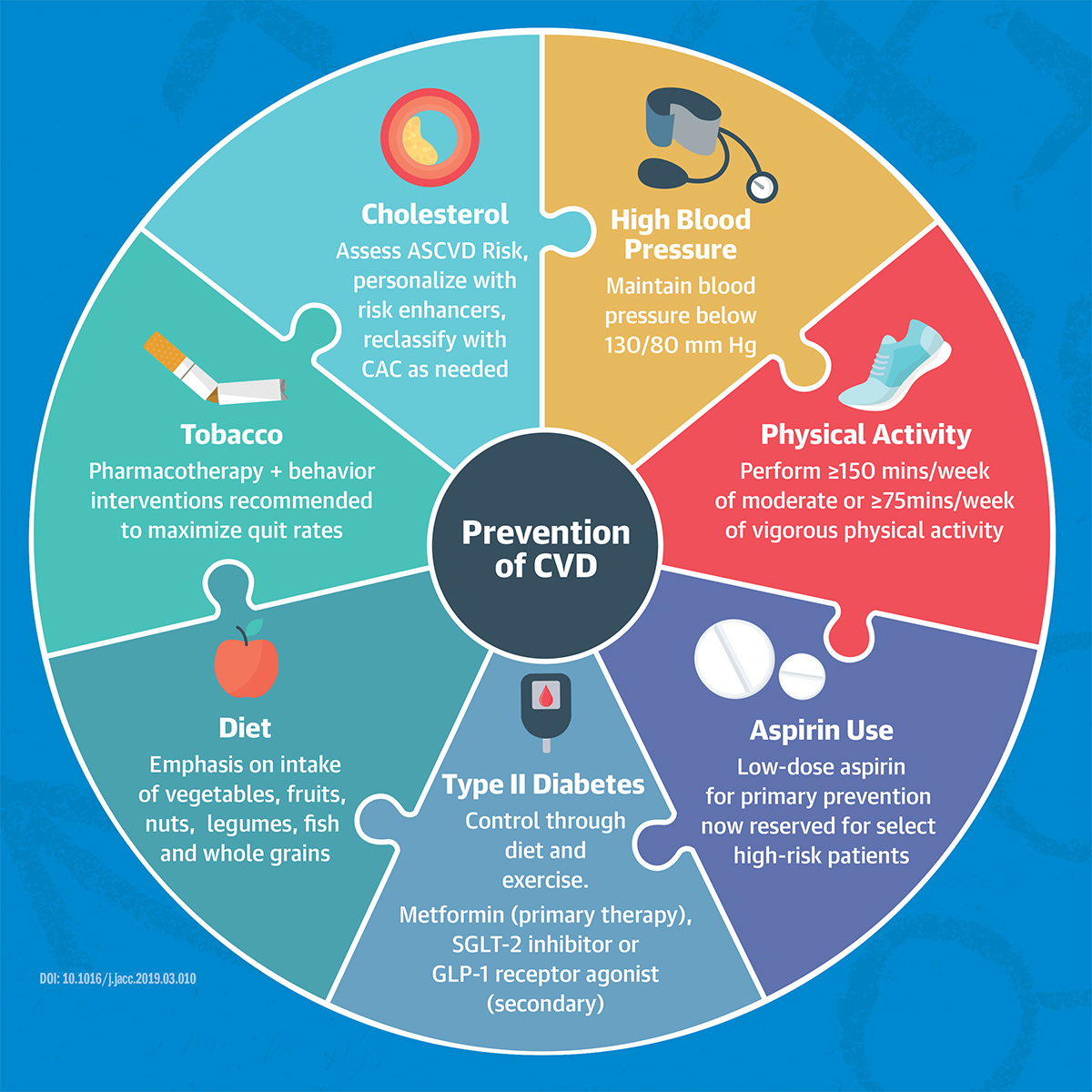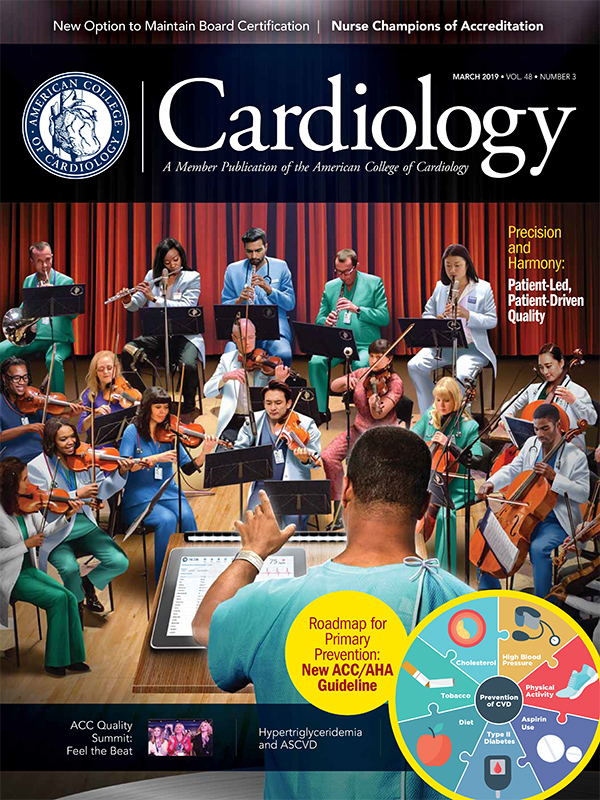Feature | ACC/AHA Primary Prevention Guideline Provides Playbook For Managing CV Risk Factors
The new ACC and American Heart Association (AHA) primary prevention guideline provides a comprehensive roadmap of strategies that can be used and tailored to help prevent or slow the development of atherosclerotic cardiovascular disease (ASCVD).
The guideline, released during ACC.19 in New Orleans, LA, also emphasizes the need to identify and address personal or social barriers (e.g., income and education levels, cost concerns, lack of health insurance, access to healthy foods or safe places to exercise, life stressors) as part of overall prevention, and sets a new tone for aspirin use, saying it should rarely be used.
"The most important way to prevent cardiovascular disease … is by adopting heart healthy habits and to do so over one's lifetime," said Roger S. Blumenthal, MD, FACC, co-chair of the 2019 ACC/AHA Guideline on the Primary Prevention of Cardiovascular Disease. "More than 80 percent of all cardiovascular events are preventable through lifestyle changes, yet we often fall short in terms of implementing these strategies and controlling other risk factors."
The guideline consolidates existing recommendations and new research, expert consensus documents, and clinical practice guidelines into a single source of guidance on the primary prevention of ASCVD. It underscores healthy lifestyle changes and risk assessment as the cornerstone of preventing cardiovascular disease and goes a step further by providing practical advice based on the latest research and proven interventions for improving diet and exercise, tobacco cessation and optimally controlling other risk factors like obesity, diabetes, high cholesterol and high blood pressure.
Some of the key lifestyle recommendations include engaging in regular exercise (at least 150 minutes of moderate-intensity activity each week); aiming for and maintaining a healthy weight; avoiding tobacco (including vaping or second-hand smoke); and eating healthier by choosing more vegetables, fruits, legumes, nuts, whole grains, and fish, while limiting trans fats, added sugars, red meats, sodium and saturated fats.
Primary Prevention: It's Elementary!
Along with the new roadmap for primary prevention for your patients, ACC is giving you the tools and resources to put it into practice.
Visit the Primary Prevention Guideline Hub at ACC.org/Guidelines/Hubs or scan the QR code to get started.
Dig into the full guideline, latest summaries and JACC commentary to help you dissect the latest guideline. And don't miss the Guidelines Made Simple Tool.
Download the updated Guideline Clinical App to put the full primary prevention guideline in your pocket for daily use. And download the updated ASCVD Risk Estimator Plus app.
Recommendations related to team-based care, shared decision-making, and assessment of social determinants of health are also included. "Social determinants of ASCVD risk – and their impact on the patient's ability to prevent or treat risk factors – must be taken into account," the authors said. "Clinicians need to consider patients' health literacy and education levels and assess patients' motivation to improve their lifestyle habits."
Other guideline highlights include a recommendation that aspirin rarely be used to help prevent heart attacks and stroke in people without known cardiovascular disease. The authors cite recent research suggesting the bleeding risks associated with aspirin may outweigh the benefits.
"Clinicians should be very selective in prescribing aspirin for people without known cardiovascular disease," Blumenthal said. "It's much more important to optimize lifestyle habits and control blood pressure and cholesterol as opposed to recommending aspirin. Aspirin should be limited to people at the highest risk of cardiovascular disease and a very low risk of bleeding."
Additionally, based on a simplified synopsis of the latest ACC/AHA Cholesterol Guideline, the new guideline suggests statins be recommended with lifestyle changes to prevent cardiovascular disease among people with elevated LDL-C levels (≥ 190 mg/dL), type 2 diabetes, and anyone who is deemed to have a high likelihood of having a stroke or heart attack upon reviewing their medical history and risk factors and having a detailed discussion with their clinician.
However, the authors note: "Even if a blood pressure-reducing medication, lipid-lowering medication, or diabetes medication is ultimately prescribed, lifestyle goals should be emphasized on a regular basis. Only when a person's risk is sufficiently high should medications to reduce ASCVD risk be considered as part of a shared decision-making process for optimal treatment."
The 2019 ACC/AHA Guideline on the Primary Prevention of Cardiovascular Disease was simultaneously published in the Journal of the American College of Cardiology and Circulation.

Clinical Topics: Cardiovascular Care Team, Dyslipidemia, Prevention, Homozygous Familial Hypercholesterolemia, Lipid Metabolism, Nonstatins, Novel Agents, Statins, Diet, Hypertension, Smoking
Keywords: ACC Publications, Cardiology Magazine, Hydroxymethylglutaryl-CoA Reductase Inhibitors, American Heart Association, Risk Factors, Tobacco, Tobacco Use, Tobacco Smoke Pollution, Blood Pressure, Aspirin, Fabaceae, Health Literacy, Tobacco Use Cessation, Goals, Diabetes Mellitus, Type 2, Motivation, Social Determinants of Health, Hypercholesterolemia, Cholesterol, Atherosclerosis, Stroke, Myocardial Infarction, Risk Assessment, Primary Prevention, Life Style, Hypertension, Habits, Insurance, Health, Obesity, Diet
< Back to Listings

